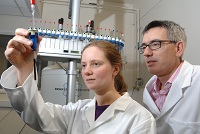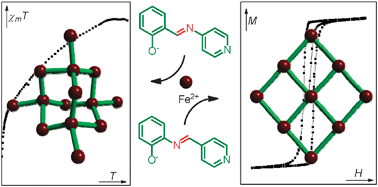News Library
Daniel Phillips wins RSC Poster Prize
Daniel Phillips , a 2nd year PhD student in the Gibson Group
, a 2nd year PhD student in the Gibson Group , won the prize for best poster at the RSC Postgraduate Nanoscience Symposium held at the University of Birmingham.
, won the prize for best poster at the RSC Postgraduate Nanoscience Symposium held at the University of Birmingham.
Read some of Dan's publications in Chem Commun and Biomacromolecules
Two photons are better than one
Sadler and Stavros groups in collaboration with Prof Martin Paterson at Heriot-Watt University, publish work in Angewandte Chemie International Edition. The work describes the first demonstration of a 2-photon activated, square planar platinum (II) complex. The enhanced photolabilization demonstrated may be useful in the design of novel photoactivatable platinum chemotherapeutic agents in situations where deep tissue penetration is needed. Read the article here.
Metal-Organic Framework Materials in Chemical Communications
The group of Richard Walton have this month co-authored three papers published in the Royal Society of Chemistry journal Chemical Communications on various aspects of porous metal-organic framework (MOF) materials.
Irène Joliot-Curie Conference - Establishing an Independent Career in Chemistry
Establishing an independent academic career is an exciting and challenging process. The data available for UK chemistry suggests that more women than men find the process not exciting enough or too challenging. A key aspect of success in any career path is finding role models, establishing networks, and being tapped into good sources of information. Our aim is therefore to create opportunities for all of these in the first (and subsequent) Irène Joliot-Curie conference.
Unique pathway for pyrrole biosynthesis discovered
Prof. Greg Challis and Dr Lijiang Song, in collaboration with researchers at the University of Paris, report in Angewandte Chemie a hitherto unanticipated pathway for the biosynthesis of pyrroles from sugars. Using a combination of genetic engineering, isolation, structure elucidation, synthesis and feeding of biosynthetic intermediates, and incorporation of stable isotope-labelled precursors, the researchers showed that a carbohydrate, most likely N-acetylglucosamine-1-phosphate, is elaborated to the 4-acetamidopyrrole-2-carboxylate building blocks of the DNA-binding antibiotic congocidine (also known as netropsin). The assembly of pyrroles from carbohydrates is unprecedented in Nature and raises several intriguing questions regarding the mechanisms of the reactions involved. See http://onlinelibrary.wiley.com/doi/10.1002/anie.201201445/abstract for further details.
Nanodiamonds bring back sparkle to cleaning
Nanodiamonds have been found to help loosen crystallized fat from surfaces in a project led by Dr Andrew Marsh at University of Warwick. The tiny carbon particles transform the ability of surfactants to shift dirt in cold water, findings that could bring eco friendly low temperature laundry cycles.
The research is published in ACS Applied Materials and Interfaces and highlighted in the Daily Mail and Daily Telegraph, 26 June.
Nanodiamond Promotes Surfactant-Mediated Triglyceride Removal from a Hydrophobic Surface at or below Room Temperature Xianjin Cui, Xianping Liu, Andrew S. Tatton, Steven P. Brown, Haitao Ye, and Andrew Marsh ACS Applied Materials and Interfaces 2012, http://dx.doi.org/10.1021/am300560z
Unwin and O'Reilly win prestigious RSC awards
Pat Unwin and Rachel O’Reilly win 2012 Royal Society of Chemistry Awards in recognition of significant contributions to their research fields
Resolutely Pure Helices
Warwick antibiotic complexes appear in Nature Chemistry News & Views article by Janice Aldrich-Wright.
- "...a simplicity and an elegance of design that should be a source of inspiration for future studies...
- ...easily tuned to explore structure–function relationships that are crucial in biological applications...
- ...good antibiotic activity against...MRSA and E. coli as well as low toxicity to Caenorhabditis elegans.
- ...potential to develop into a family of cost-effective antibiotics."
Stimuli Responsive Polymers Tuned for Specific Intracellular Degradation
The Gibson group have reported in Chemical Commmunications on a new route to obtain polymers containing disulfide linkages in their backbone. These linkages are appealing for drug delivery applications as they are stable in the blood stream but can be specifically degraded inside cells. Traditional controlled radical polymerizations produce all-carbon backbones which do not degrade but, in this paper, the authors demonstrate how a 2-stage polymerization process can be used to incorporate disulfides. Furthmore this allows the use of functional monomers which result in 'smart' materials capable of responding to thermal gradients.
This was published in Chemical Communications link
More information on the Gibson Group can be found here link
‘Left-handed iron corkscrews’ point the way to new weapon in battle against superbugs like MRSA

 Scientists at the University of Warwick have taken inspiration from corkscrew structures found in nature to develop a new weapon in the fight against infections like E-coli and MRSA.
Scientists at the University of Warwick have taken inspiration from corkscrew structures found in nature to develop a new weapon in the fight against infections like E-coli and MRSA.
Researchers have created a new synthetic class of helix-shaped molecules which they believe could be a key tool in the worldwide battle against antibiotic resistance. By twisting molecules around iron atoms they have created what they term ‘flexicates’ which are active against MRSA and E-coli - but which also appear to have low toxicity , reducing the potential for side effects if used in treatment. The work is published in Nature Chemistry.
The new structures harness the phenomenon of ‘chirality’ or ‘handedness’ whereby the corkscrew molecules could be left-handed or right-handed. By making the most effective ‘hand’ to attack a specific disease, the University of Warwick research paves the way towards a more targeted approach to killing pathogens. In the case of E-coli and MRSA, it is the left ‘hand’ which is most effective.
Professor Peter Scott of the University of Warwick’s chemistry department said although this particular study concentrated on flexicates’ activity against MRSA and E-coli, the new method of assembly could also result in new treatments for other diseases.
“It’s a whole new area of chemistry that really opens up the landscape to other practical uses. These new molecules are synthetically flexible, which means that with a bit of tweaking they can be put to use against a whole host of different diseases, not just bugs like MRSA which are rapidly developing resistance to traditional antibiotics. Flexicates are also easier to make and produce less waste than many current antibiotics.”
Scientists have long been able to copy nature’s corkscrew-shaped molecules in man-made structures known as helicates – but they have thus far not been able to use them in fighting diseases. One of the key issues is the problem of handedness. Sometimes ‘left-handed’ molecules in drugs are the most effective at combating some disease, while sometimes the ‘right-handed’ version works best. Until now, scientists working with helicates have found it difficult to make samples containing just one type of corkscrew; either the right- or left-handed twist.
With flexicates, the University of Warwick scientists have succeeded in making samples containing just one type of twist – resulting in a more targeted approach which would allow the drug dosage to be halved. Flexicates solve other problems encountered by helicates, as they are easier to optimise for specific purposes, are better absorbed by the body and are easier to mass-produce synthetically.
Professor Scott said: “Drugs often have this property of handedness - their molecules can exist in both right and left handed versions but the body prefers to use only one of them. For this reason, drug companies have to go to the trouble of making many traditional molecules as one hand only. What we have done is solve the ‘handedness’ problem for this new type of drug molecule. By getting the correct hand we can halve the drug dose, which has the benefits of minimising side effects and reducing waste. For patients, it’s safer to swallow half the amount of a drug. Our work means that we can now make whichever hand of the corkscrew we want, depending on the job we require it to do.”
Notes to editors
The study, entitled Optically pure, water-stable metallo-helical ‘flexicate’ assemblies with antibiotic activity, is published in Nature Chemistry.
The research was also supported financially by EPSRC.
It is authored by Peter Scott, Suzanne Howson, Guy Clarkson and Alison Rodger from the University of Warwick, Albert Bolhuis from the University of Bath and Viktor Brabec and Jaroslav Malina from the Academy of Sciences of the Czech Republic.
When the paper is published it can be retrieved at http://dx.doi.org/10.1038/NCHEM.1206
Contact details
Professor Peter Scott is available on +44 (0) 24 7652 3238 or peter.scott@warwick.ac.uk
University of Warwick press officer Anna Blackaby is available on + 44 (0) 2476 575910 or + 44 (0)7785 433155 or a.blackaby@warwick.ac.uk
Front Page Artwork by Elisabeth Heissler http://ehgraphicdesign.co.uk/
Simple compounds, hard magnets
New magnetic materials have been created from simple components by Lihong Li, a Warwick Postgraduate Research Fellow and co-workers in the Scott group at Warwick University. The resarchers have engineered magnetic diamond-like 3D networks and layered 2D net structures. A rare example of a molecular hard magnet (which like a regular magnet keeps its magnetic properties over time) is produced. The chemistry is simple, reliable and scalable so the group hope to make many new materials in the future for applications in data storage, and quantum computing. The work is published in Chemical Communications.
Precious metal materials
Walton’s group, in collaboration with colleagues in the Department of Physics and at Johnson Matthey plc have a paper published this week in the RSC journal Chemical Science: this describes mild synthetic chemical routes to complex extended structures that contain the metal iridium in various oxidation states. This illustrates the scope for the discovery of new functional materials by exploration of novel reaction conditions and using the chemistry of lesser studied elements.
http://pubs.rsc.org/en/content/articlelanding/2011/sc/c1sc00192b/

